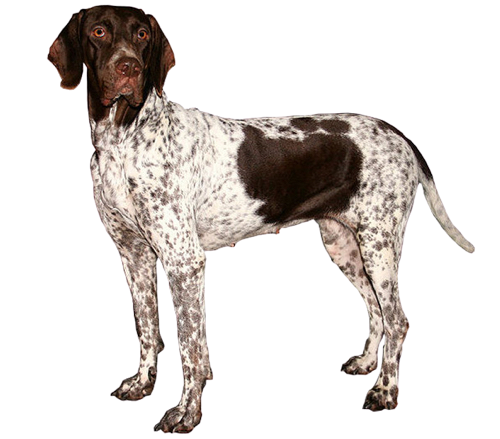
Old Danish Pointer
USD $800-$1000 Price Avg.
Hunting Dogs
Group
Purebred
Breed Type
Large
Size
12-14 years
Lifespan
Breed Information
| Group | Hunting Dogs |
|---|---|
| Popularity/Rank | 225 |
| Origin | Denmark |
| Other Names | Altdänischer Hühnerhund, Ancien chien d′arrêt danois, Gammel Dansk Honsehund, Old Danish Bird Dog, Old Danish Pointing Dog |
| Breed Type | Purebred |
| Price (Avg.) |
USD $800-$1000
How much does it cost to purchase a Old Danish Pointer? The price of a Old Danish Pointer will vary from breeder to breeder as well as from place to place. As a rough guide, you should expect to pay between $800 to $1000 per Old Danish Pointer if you purchase from a reputable breeder. Prices will be higher for show-quality dogs with a distinguished pedigree. Adult dogs who have already been trained may cost even more. It is usually less expensive to adopt a Old Danish Pointer through a shelter. |
| Size | Large |
| Weight |
Male: 66-77 pounds (30-35 kg),
Female: 57-68 pounds (25-30 kg) |
| Height |
Male: 21-24 inches (53-61 cm),
Female: 20-22 inches (51-56 cm) |
| Lifespan | 12-14 years |
| Recognized by |
FCI
Not recognized by the American Kennel Club. And FCI in the Pointing Dogs group, in the Continental Pointing Dogs section. |
| Purpose | Bird Hunting |
| Date of Origin | 1710 |
| Ancestry | Bloodhound, Spanish Pointing Dogs, Squire Scent Hound |
Appearance & Maintenance
| Coat | Dense, Smooth |
|---|---|
| Coat Colors | White & Brown |
| Grooming Level | |
| Shedding Level | |
| Eye Color Possibilities | Brown |
| Nose Color Possibilities | Brown |
| Coat Color Possibilities | Brown, Pied, White |
| Coat Length | Medium |
| Coat Density | Normal |
| Coat Texture | Straight |
| Recommended Brushes | Comb, Nail Clipper, Slicker Brush |
| Brushing Frequency | Weekly |
Breed Characteristics
| Temperament | Brave, Calm, Intelligent, Loyal, Resolute |
|---|---|
| Intelligent | |
| Trainability | |
| Playfulness | |
| Sensitivity Level | |
| Affection Level | |
| Social Interaction Required | |
| Barking | |
| Watchdog Ability | |
| Territorial | |
| Biting Force | Low |
| Mouthiness | |
| Impulse to Wander or Roam | |
| Prey Drive | |
| Adaptability | |
| Tolerates Being Left Alone | |
| Fighting Dog | Not really |
Good & Friendly with
| Apartment Life Friendly | |
|---|---|
| Stranger Friendly | |
| Kid-Friendly | |
| Cat Friendly | |
| Dog Friendly | |
| Office Friendly | Yes |
| Senior Citizens Friendly | |
| Pet Friendly | |
| Friendly with First Time Owners | No |
| Service Dog | Not really |
| Therapy Dog | Not really |
| Detection, Sniffer or Security Dog | Not really |
| Search and Rescue Dog (SAR) | Not really |
| Boat Dog | Not really |
| Cart Pulling or Drafting Dog | Not really |
Health Elements
| Health Issues | |
|---|---|
| Hypoallergenic | No |
| Energy Level | |
| Exercise Required | |
| Sleeping Required | |
| Weight Gain Potential | |
| Weather & Climate | Prefers average to warm weather conditions |
| Stinkiness | Medium |
| Drooling tendency | |
| Activity Level | High |
| Rec. Walk Mileage Per Week | 9 miles |
| Minutes of Activity Per Day | 45 minutes |
Food & Costing
| Avg. Daily Food | 3 to 4 cups of high-quality dry food a day, divided into two meals. |
|---|---|
| Cups Per Day | 2.3 cups |
| Daily Cost | $1.20 - $1.40 |
| Monthly Cost | $34.00 - $45.00 |
Reproducibility
| Gestation Duration | 60-64 days |
|---|---|
| How often can the Old Danish Pointer have a litter? | Once a year. |
| Litter Size | 4-6 puppies (Once a year.) |
Description
The Old Danish Pointer is a medium-sized breed of dog that originated in Denmark. It is an active and intelligent breed that is known for its loyalty and affectionate nature. The Old Danish Pointer has a strong, muscular body with a short, dense coat that comes in various colors including black, white, brown, red and yellow. The average lifespan of the Old Danish Pointer is between 12 to 14 years.
The size of the Old Danish Pointer varies depending on gender; males typically weigh between 55 to 65 pounds while females weigh between 45 to 55 pounds. The height of the breed ranges from 20 to 24 inches at the shoulder.
The personality of the Old Danish Pointer is friendly and loyal; they are very devoted to their owners and make excellent family pets. They are also very intelligent dogs that can be trained easily with patience and consistency.
Old Danish Pointers are generally friendly with other dogs, cats, children, and other animals if they have been properly socialized from an early age. They do not usually show aggression towards strangers but may bark when they sense danger or unfamiliar people around them.
The temperament of the Old Danish Pointer is alert yet gentle; they are eager to please their owners but can be stubborn at times if not given proper training or guidance from an early age. They need plenty of exercise as well as mental stimulation in order to stay healthy both physically and mentally.
The health of the Old Danish Pointer is generally good but like all breeds there are some health issues that may arise such as hip dysplasia or eye problems so it’s important for owners to keep up with regular vet checkups for their pet’s well-being.
The adaptability level of the Old Danish Pointer is high; they do well in both rural and urban environments as long as they get plenty of exercise each day such as long walks or runs in open spaces where they can explore new sights and smells without being confined indoors all day long.
Overall, the benefits of owning an Old Danish Pointer include having a loyal companion who loves spending time with you no matter what activity you choose! They also make great watchdogs due to their alertness yet gentle nature which makes them perfect for families looking for a loving pet who will always be there when needed most!
History
The Old Danish Pointer is a breed of dog that was once popular in Denmark. The breed almost became extinct in the early 1900s, but was saved by a few dedicated breeders. The Old Danish Pointer is now recognized as a breed by the Danish Kennel Club and is gaining popularity in other countries.
The Old Danish Pointer is thought to be descended from the German Shorthaired Pointer and the English pointer. The breed was first recognized as a distinct breed in Denmark in the late 1800s. At that time, the Old Danish Pointer was used for hunting game birds such as pheasants and quail.
The Old Danish Pointer became popular in Denmark due to its hunting ability and its friendly personality. However, the breed nearly became extinct in the early 1900s due to a lack of interest from hunters and breeders. A few dedicated breeders kept the breed alive, and it eventually regained popularity in Denmark.
The Old Danish Pointer is now recognized as a distinct breed by the Danish Kennel Club and is gaining popularity in other countries. The breed is still used for hunting, but is also becoming popular as a companion dog.


